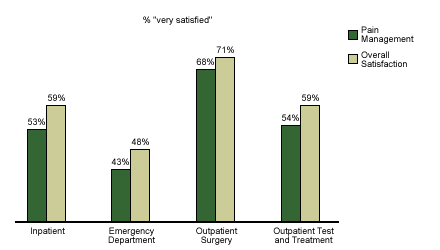Pain management has become a high-profile issue in both the private and public sectors. In October 2000, Congress passed a bill establishing the "Decade of Pain Control and Research," which began on January 1, 2001. The American Medical Association also emphasized its commitment to this issue in July 2001, by passing a resolution to educate medical students and physicians on effective pain-management guidelines.
The Joint Commission on Accreditation of Healthcare Organizations (JCAHO), a non-profit organization that evaluates and accredits nearly 18,000 healthcare organizations in the U.S., published revised standards on pain management in 2001. Among them are patients' rights to "appropriate assessment and management of pain" and organizations' responsibilities to ensure that "the pain of all individuals is recognized and addressed appropriately."
Hospital Performance on Pain Management
The only way to find out how well hospitals are controlling pain is to ask their patients. To that end, we examined ║┌┴¤═°'s 2001 patient loyalty database, which contains the responses of thousands of patients who were asked if hospital staff members effectively managed their pain. Results are broken down by patient-care type in the chart below.

The percentage of patients who were "very satisfied" with their hospital's pain management ranges from 68% of those who received outpatient surgery to 43% of those who went through the emergency department. These patterns are remarkably similar to the variations in overall satisfaction with healthcare services received. In all instances, satisfaction with pain management is 3% to 6% below overall satisfaction scores for that category.
Key Points
Pain management received a great deal of focus among healthcare organizations in 2001, but that aspect of their care still lags behind respondents' overall evaluation of the services they receive. The service type of greatest concern is the emergency department, in which only about two in five patients report being very satisfied with the way their pain was managed.
The first year in the Decade of Pain Control and Research has given healthcare organizations a baseline measure of pain-management success, and there is obviously considerable room for improvement. Continued attention to the following four elements of the JCAHO standards should result in a pattern of continued progress:
- Initial and regular assessment of pain
- Education of relevant providers in pain assessment and management
- Education of patients and families regarding their roles in managing pain, as well as the potential limitations and side effects of pain treatments
- Communicating to patients and families that pain management is an important part of care, while considering personal, cultural, spiritual or ethnic beliefs